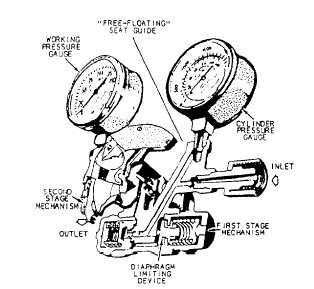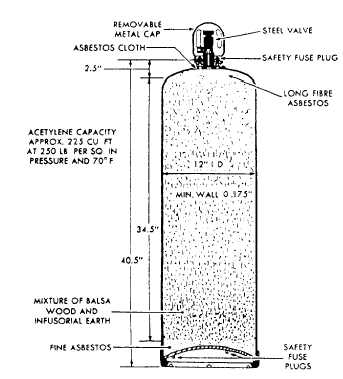Figure 15-26.—Two-stage regulator.
working pressure is held constant, and pressure
adjustment during welding operations is not required. A
two-stage regulator is shown in figure 15-26.
The acetylene regulator controls and reduces the
acetylene pressure from any standard cylinder that
contains pressures up to 500 psi. It is of the same general
design as the oxygen regulator, but it will not withstand
such high pressures. The high-pressure gauge, on the
inlet side of the regulator, is graduated from 0 to 500 psi.
The low-pressure gauge, on the outlet side of the
regulator, is graduated from 0 to 30 psi. Acetylene
should not be used at pressures exceeding 15 psi.
ACETYLENE.—Acetylene is a fuel gas made up of
carbon and hydrogen. It is manufactured by the chem-
ical reaction between calcium carbide, a gray stonelike
substance, and water in a generating unit. Acetylene is
colorless, but it has a distinctive odor that can be easily
detected.
Mixtures of acetylene and air that contain from 2 to
80 percent of acetylene by volume will explode when
ignited. However, with suitable welding equipment and
proper precautions, acetylene can be safely burned with
oxygen for welding and cutting purposes. When burned
with oxygen, acetylene produces a very hot flame that
has a temperature between 5,700°F and 6,300°F.
ACETYLENE CYLINDERS.—Acetylene stored
in a free state under pressure greater than 15 psi can be
made to break down by heat or shock and possibly
explode. Under pressure of 29.4 psi, acetylene becomes
self-explosive, and a slight shock will cause it to explode
spontaneously. However, when dissolved in acetone, it
Figure 15-27.—Acetylene cylinder.
can be compressed into cylinders at pressures up to 250
psi.
The acetylene cylinder (fig. 15-27) is filled with
porous materials, such as balsa wood, charcoal, and
shredded asbestos, to decrease the size of the open
spaces in the cylinder. Acetone, a colorless, flammable
liquid, is added until about 40 percent of the porous
material is filled. The filler acts as a large sponge to
absorb the acetone, which, in turn, absorbs the
acetylene. In this process, the volume of the acetone
increases as it absorbs the acetylene, while acetylene,
being a gas, decreases in volume. The acetylene
cylinders are equipped with safety plugs, which have a
small hole through the center. This hole is filled with a
metal alloy, which melts at approximately 212°F or
releases at 500 psi. When a cylinder is overheated, the
plug will melt and permit the acetylene to escape before
a dangerous pressure can build up. The plug hole is too
small to permit a flame to burn back into the cylinder if
the escaping acetylene should become ignited.
WELDING TORCHES.—The oxyacetylene
welding torch is used to mix oxygen and acetylene gas
in the proper proportions, and to control the volume of
these gases burned at the welding tip. The torch has two
needle valves, one for adjusting the flow of acetylene
and the other for adjusting the flow of oxygen. In
addition, there are two tubes, one for oxygen and the
other for acetylene; a mixing head; inlet nipples for the
attachment of hoses; a tip; and a handle. The tubes and
15-20





